|
|
 |
|
|
WWIII: Nordic Forces Spotlight
|
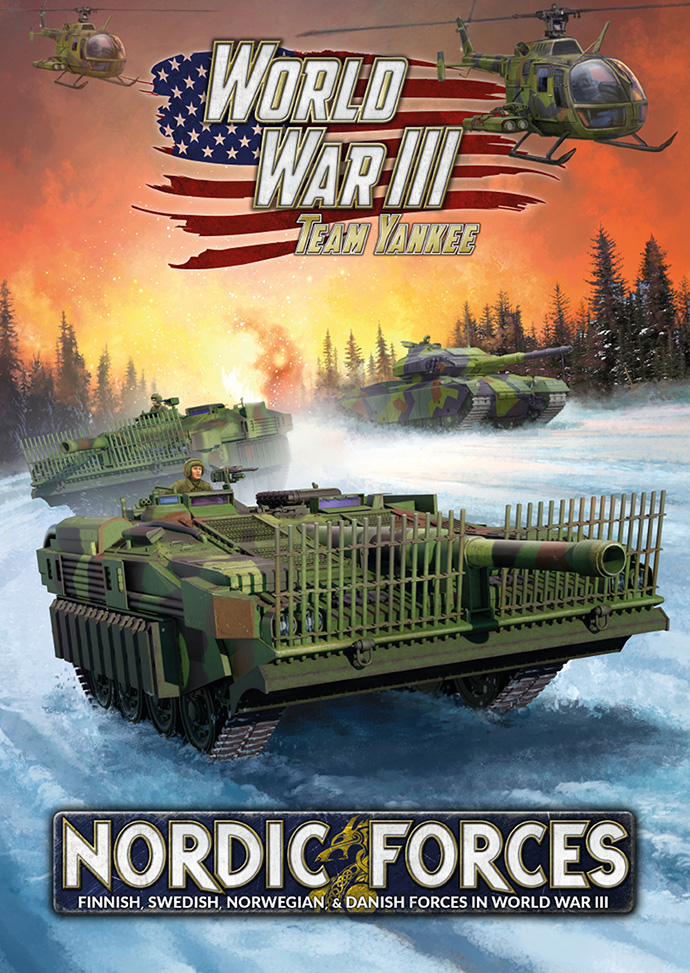
|
WWIII: Nordic Forces Spotlight
We talk Northern Front with Wayne Turner
It’s 1985 and the Cold War just got hot!
Löjtnant Lars Nilsson watched the road from the cupola of his Strv 103 S-Tank. His platoon had been positioned in a treeline waiting for the enemy to appear since the previous day.
About mid-morning the first Soviet vehicles crested a dip in the road. Nilsson’s gunner/driver, Karlsson, spotted it first, “BRDM, 1000 metres, sir,” he stated before ducking back into his hatch to take up his position.
“Enemy vehicles, 1000 metres east, on road, free fire,” Nilsson informed his platoon.
Meanwhile, Karlsson had already shot at the Soviet armoured car. The sabot projectile tore through the lightly armoured vehicle, and its smoking wreck rolled off the road into a tree.
Nilsson then saw the trees dividing a field shaking, before a tank emerged into the field.
“Tanks, 1500 metres, treeline and field,” he informed the platoon. A ripple of 105mm fire travelled down the platoon’s position.
|
|
Check out WWIII: Nordic Forces in the online store here...
|
|
Both Norway and Denmark were quick to join NATO after its establishment in 1949. However, Sweden and Finland remain neutral, each for their own reasons, but always wary of their massive Soviet neighbour.
Inside You Will Find:
Background on World War III in Finland, Sweden, Norway, and Denmark.
Instructions on how to build:
-
Finnish T-72FM1, T-72FM2, or T-55M Armoured Companies, and BMP-1 or BTR-60 Jääkäri Companies,
-
Swedish Strv 103 S-Tank or Strv 104 Centurion Tank Companies, and Pbv 302 Armoured Rifle Companies,
-
Norwegian Leopard 1 Tank Squadrons, and M113 Storm Squadrons,
-
Danish Leopard 1 or Centurion DK Tank Squadrons, and M113 Armoured Infantry Companies.
-
Three scenarios featuring World War III: Nordic Forces.
-
Detailed painting guides to help you prepare your Forces for combat.
|
|
Click on the nations below to jump to their section, or scroll on to read them all!
|
|

|
 |
 |
 |
|
|
Finland
The Soviet high command had a number of wartime plans for Finland. Some involved the invasion and conquest of the whole of Finland, with Helsinki, Vaasa, and Oulu as the primary Soviet objectives and even involved the use of Finland as a launch point for the invasion of Sweden. Other plans varied between limited offensives, allowing Finland to maintain its neutrality, or requests for access to Finnish territory for troop movements.
However, the Soviet Union’s main goal was the domination of the Norwegian Sea and Northern Norway to support the free passage of its Northern Fleet into the North Sea and the Atlantic Ocean. For this, they initially demanded the Finns give them free passage across Lapland for Soviet northern forces attacking Norway. When the Finns refused, the Soviets instead attacked through Lapland towards Norway.
Other Soviet forces also attacked southern Finland, tying down the bulk of the Finnish Defence Forces around their main population centres.
|
|
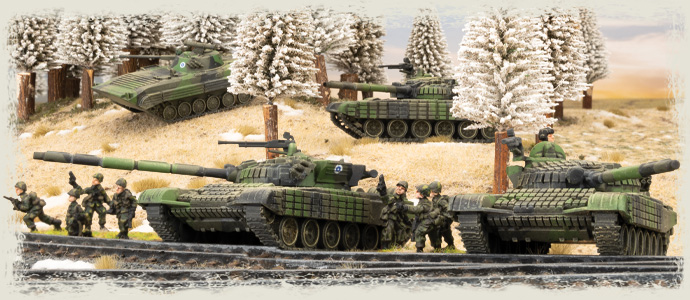
|
| The Finnish armoured forces field T-72FM1, T-72FM2, and T-55M Soviet tanks with local improvements and newer Western technology applied. Their Jääkäri (Jäger) infantry are mounted in BMPs and BTR-60s with missiles, recoilless rifles, and mortars for fire support. |
|
Finnish Formations
A Finnish T-72FM1 Armoured Company is equipped with three tank platoons armed with the T-72FM1, which is a variant of the Soviet T-72M1 export version. 65 of these were purchased from the Soviet Union in 1984. Soon after, they planned an upgrade program to their T-72 fleet. The first stage of this was the T-72FM1 (Finmod 1) which consisted of a new power plant, a new Western Fire Control System, and new ammunition. This gives the Finnish version of the T-72 a better range and anti-tank 22, equal to that of the standard Soviet T-72, T-64, and T-80.
|
|
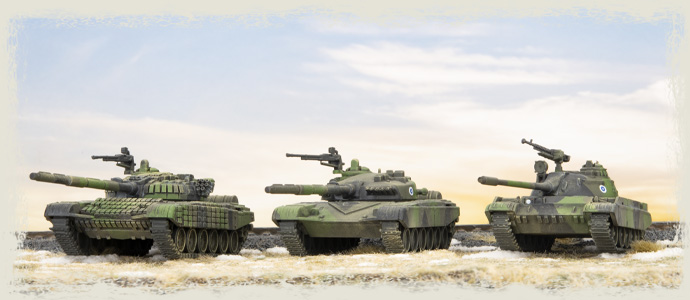
|
|
Further upgrades lead to the T-72FM2 (FM2 or Finmod 2) which added ERA armour (Kontakt-1) to the new engine, fire control system, and ammunition. This gives the T-72FM2 the same improvements as the T-72FM1 with Front armour 17 (instead of 15) and the benefit of ERA (Side armour 16 versus HEAT weapons).
The third type of Armoured Company is armed with the T-55M. With the arrival of the T-72 tanks, the Finnish T-55 tanks were relegated to the Reserve Armoured brigades. However, after the T-55 tanks’ extensive upgrade to the T-55M, many considered it a superior tank to the unmodified T-72Ms as they arrived from the Soviet Union, with the T-55M crews out-shooting the T-72s in early exercises. The T-55M upgrade consisted of an improved Swedish Bofors fire control system, Belgian Mecar armour piercing fin-stabilised discarding sabot ammunition (APFSDS) and a thermal sleeve added around the gun barrel to improve accuracy. The Finnish T-55M has an improved 100mm gun range, a Laser Rangefinder and anti-tank 19.
|
|
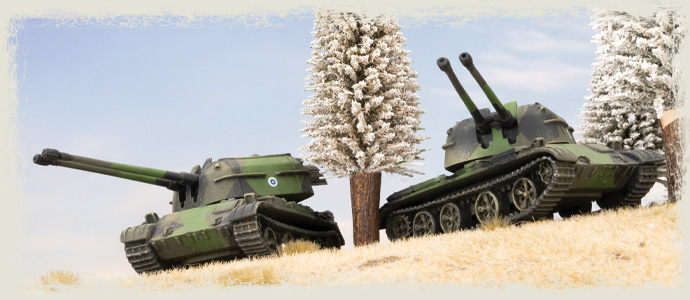
|
|
All three of these Formations can take other types of tanks as their third armour unit as well as a 2s1 Carnation Howitzer Battery and a ZSU-57-2 Anti-aircraft Platoon.
The BMP mounted Jääkärikomppania (light infantry or jäger company) in the armoured battalions consisted of three armoured infantry platoons and an 81mm mortar platoon. They also have their own anti-aircraft missiles and 95mm recoilless rifle anti-tank platoons. Further indirect fire support comes from 120mm mortars. They can also have an attached Armoured Platoon.
|
|
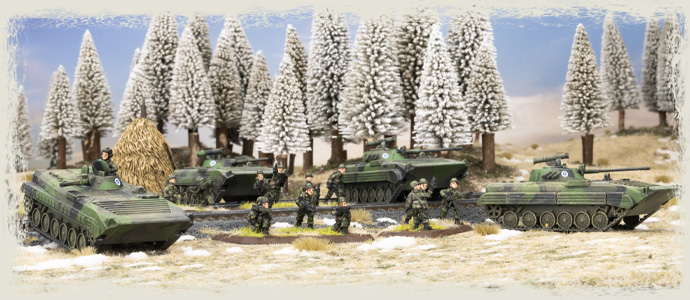
|
|
Most of these armoured infantry platoons were mounted in BMP-1, some Formations had one platoon mounted in newer BMP-2 infantry fighting vehicles. The Finnish BMP-1s mounted the PstOhj 82 (Soviet AT-4) missile, giving them a potent anti-tank 19 guided weapon against enemy tanks.
The BTR-60 Jääkäri Company is similarly organised but mounted in 8-wheeled BTR-60 APCs.
|
|
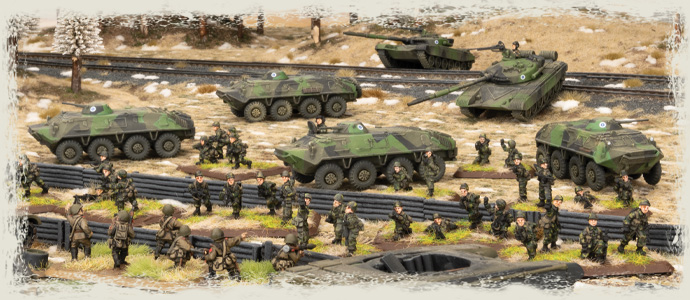
|
|
Finnish support includes BM-21 Hail rocket launchers, T-55 Marksman anti-aircraft tanks, Anti-tank Missile Platoons with improved TOW missiles, and BMP-2 Recon.
Finns have access to NATO Allies as Formations, as well as Swedish Units as part of their Force Diagram.
Overall, the Finns have the feel of a Western-style force with Soviet equipment.
|
|
Finnish Models
The Finns use the Soviet T-72 (TSBX29) for the T-72FM1, and the T-72B (TSBX29) for the T-72FM2. The T-55M uses the Soviet T-55 (TSBX22) kit. There infantry ride in BMP-1 or BMP-2 (TSBX02) or BTR-60 (TSBX14). They use other Soviet vehicles like the 2s1 Carnation (TSBX07), BM-21 Hail (TSBX08), and the ZSU-57-2 (TQBX03) from the Iraqi range.
|
|
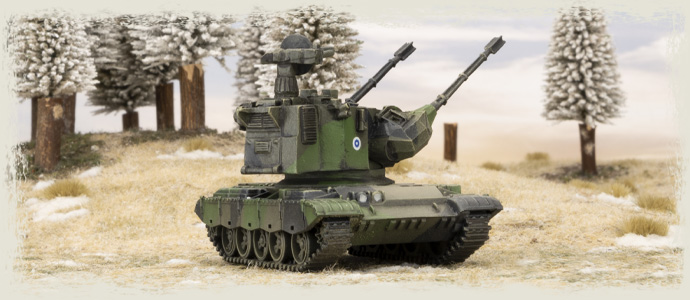
|
|
The T-55 Marksman mounts the same turret as the British Marksman on a T-55 hull and is available as its own box of three (TFIBX01).
The Finns have a whole new range of Finnish infantry (TFI702) with the appropriate 81mm and 120mm mortars (TFI704), as well as AA missile teams, anti-tank missile teams, recoilless rifles (TFI703).
|
|
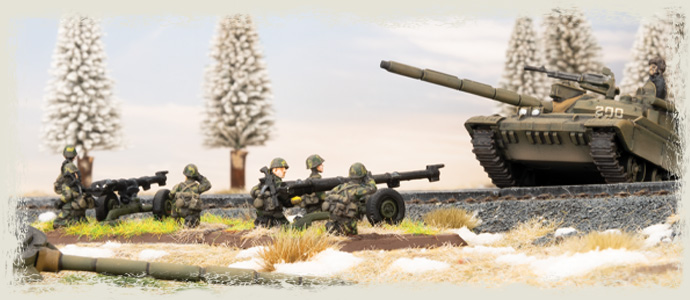
|
|
|
Sweden
The Swedes are mostly self-sufficient in their military technology with their own unique turretless S-Tank with its autoloader and powerful gun. Their well-armed infantry is mounted in the Pbv 302 APC armed with a 20mm autocannon. Supplementing their locally manufactured equipment the Swedes also field Centurion tanks, with upgraded fire-control systems and Explosive Reactive Armour.
Like NATO and the other neutral nations, Sweden was critically aware of the building tensions between the West and the Soviet bloc. Sweden began mobilising its defence forces as early as the end of June 1985 as US forces began readying to reinforce their units in West Germany. The Swedish Air Force had stepped up active patrolling and Coastal Forces were on high alert.
When Soviet forces crossed the Finnish and Norwegian borders on 7 August, Sweden immediately announced its intent to offer assistance to Finland, denouncing the Soviet Union’s blatant breach of a fellow neutral nation’s sovereignty.
|
|
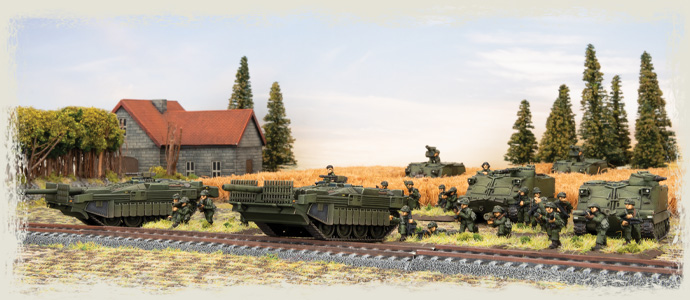
|
| Immediately, the Swedish Air Force’s ground attack squadrons began flying sorties in support of the Finnish ground forces. The Swedish Army’s anti-tank helicopter units also began flying in support of the Finns, while the northern Swedish brigades moved towards the Finnish frontier. |
|
Swedish Formations
The Swedish Strv 103 S-Tank Tank Company, or Stridsvagnskompani, was made up of four tank platoons (Stridsvagnspluton) and an armoured infantry platoon (Pansarskyttepluton). In the field, they would be attached weapons and other platoons from the battalion and brigade as required, such as additional infantry and recon.
The Stridsvagn 103 S-Tank is the first main battle tank to use a turbine engine and to dispense with a turret. This unconventional design has a unique gun laying process: its fixed gun is traversed by engaging the tracks and elevated by adjusting the hull suspension. The result was a very low-profile design with an emphasis on survivability and heightened crew protection level.
|
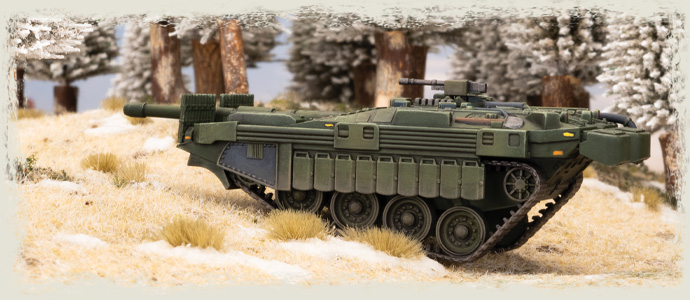 |
|
It is also fitted with an autoloader to reduce its crew size and replicated controls so that the commander or gunner may drive the tank and fire the main gun. A third crewman is a radio operator/driver and sits in a rearward-facing position from where they have another set of driving controls for rapid re-deployment. While the Strv 103 S-Tank cannot fire while moving, the autoloader combined with short halt firing tactics allows it to fight well on the advance.
The S-tanks excellent long 105mm gun has AT21 and can hit targets out to 48”/120cm. It utilised its low silhouette and hydropneumatic suspension on defence among the wooded terrain of Sweden. This is represented by the Ambush tank rule: If an S-Tank is stationary, it can remain Gone to Ground while shooting its main gun. It also has Slat (or bar) armour that is fitted to the front to improve its front and side armour to 13 versus HEAT weapons.
|
|
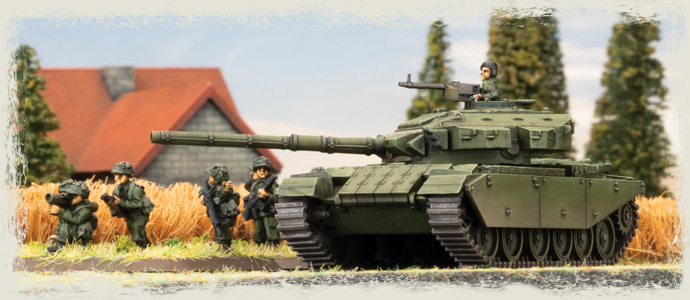
|
|
The Swedes also fielded the British Centurion. This has undergone many upgrades through the years. The latest variant is the Strv 104 Centurion. Strv 104 Centurion Tank Companies are organised like the S-Tank formations. The Strv 104 Centurion is fitted with a new American diesel engine, 120mm thick sloped armour with additional explosive reactive armour (ERA), the British 105mm L7 rifled gun, and new fire control systems (including a Laser Rangefinder).
The other half a Swedish mechanised battalion is the Pansarskyttekompanier (armoured shooter/rifle companies). Each battalion had two companies with three Pansarskyttepluton (armoured shooter/rifle platoon) and a Pansarvärnspluton (anti-tank platoon). Additional weapons units from the battalion and brigade provided further anti-tank and armoured support. The Formation can include attached Tank Platoons, Ikv91 Tracked Anti-tank Platoons, tracked or ground anti-tank missiles, mobile recoilless rifles, and recon.
|
|
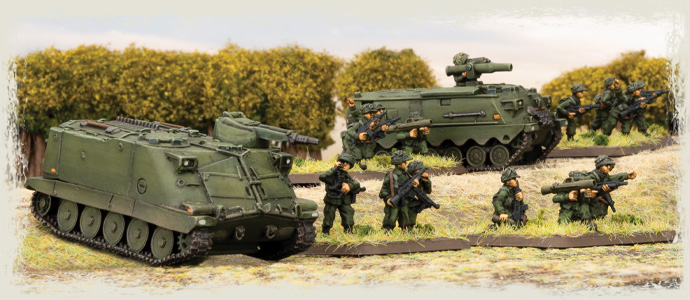
|
|
A Pbv 302 Armoured Rifle Platoon is mounted in the Pbv 302 APC mounted a 20mm autocannon. The Swedish Pansarskyttepluton (armoured rifle platoon) consists of three skyttegrupper (shooting groups) (3x Ksp-58 MG teams), as well as a granatgevärsgrupp (grenade launcher group) of 3x Grg m/48 (84mm Carl Gustav recoilless rifle) anti-tank teams. Each Skyttegrupp is usually assigned four P-skott m/68 (74mm Miniman) disposable anti-tank weapons.
The Ikv 91 (Infanterikanonvagn 91, infantry cannon wagon 91) is a high-mobility assault gun developed for the Swedish army. Its design employs common components with the Pbv 302 APC series. It is armed with a 9cm cannon and fitted with a Laser Rangefinder. It has a range of 36”/90cm and AT17.
|
|
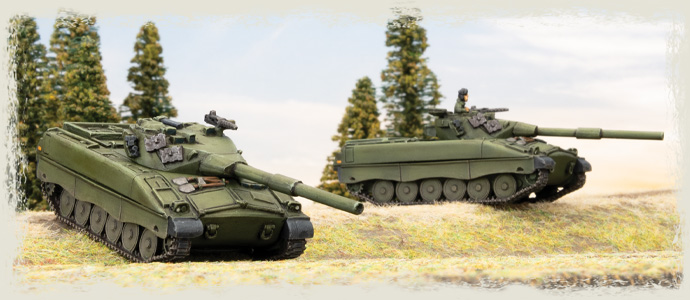
|
|
The Pvrbv 551 Anti-tank Missile Platoon is armed with the Pansarvärnsrobotbandvagn 551 (Pvrbv 551). It is a tank hunter mounting an Improved TOW anti-tank guided missile system. The American iTOW (Swedish designation: RBS-55) gives it good range (48”/120cm, Guided) and anti-tank capabilities (AT21, HEAT).
Another unique Swedish vehicle is the Pvpjtgb, which is the Swedish military abbreviation of Pansarvärnspjästerrängbil (armoured defence patrol car), the Volvo C303 off-road vehicle. In the Pvpjtgb RBS Anti-tank Missile Platoon, it mounts either the RBS-55 iTOW or RBS-56 BILL anti-tank guided missile systems. In the Pvpjtgb 90mm Anti-tank Platoon, it mounts the Pvpj 1110 Bofors 90mm recoilless anti-tank gun.
|
|
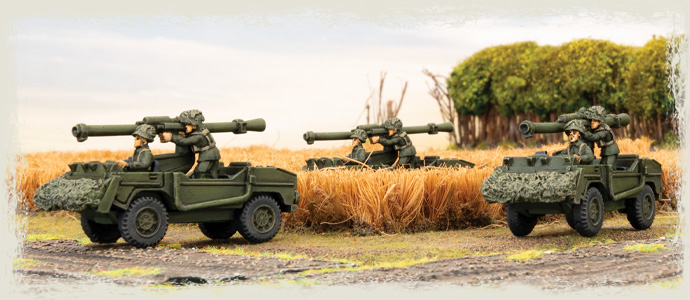
|
|
Swedish Support comes from self-propelled artillery, self-propelled anti-aircraft missile vehicles, HKP 9 anti-tank helicopters, Viggen strike aircraft, plus further anti-tank missile and anti-tank units and recon.
Swedes have access to NATO Allies as Formations, as well as Finnish Units as part of their Force Diagram.
|
|
Swedish Models
The Swedish range introduced the excellent S-tank as a plastic kit available in a box of three tanks (TSWBX1).
The Strv 104 Swedish Centurion tank is the first of our Centurion plastic kits to come out and comes in a box of five tanks (TSWBX02).
The Ikv 91 tanks are available as resin kits in a box of three tanks (TSWBX04).
The massive Bandkanon 1 Self-propelled gun, Sweden’s autoloading 155mm artillery also comes in a box of three resin kits (TSWBX06)
|
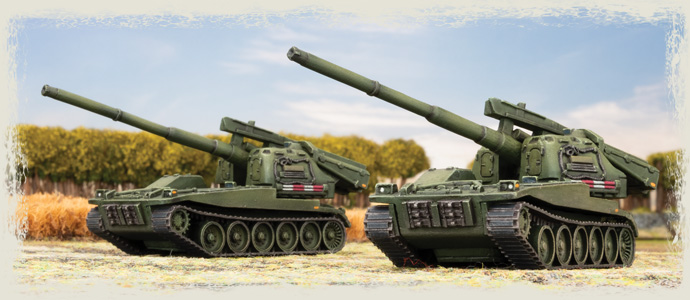 |
|
The Pvpjtgb 1111 Platoon (TSW120) provides you with four vehicles with all the resin parts to make Pvpjtgb 90mm Recoilless Rifle Jeeps, Pvpjtgb RBS-55 iTOW Anti-tank Missile Jeeps, or Pvpjtgb RBS-56 BILL Anti-tank Missile Jeeps.
The Pbv 302 Platoon (TSWBX03) contains a box of 4 vehicles for your infantry transport or recon and includes parts to make the specialist Epbv 3022 OP observation vehicle.
The Pvrbv 551 or Lvrbv 701 Platoon (TSWBX05) lets you make either three Pvrbv 551 TOW Carriers or three Lvrbv 701 SAM Carriers.
To make the Swedish HKP 9 anti-tank helicopter you combine the HKP 9 Missile Launchers (Direct Only) (TSWSO02) pack with a West German PAH Anti-tank Helicopter Flight (TGBX12).
|
|
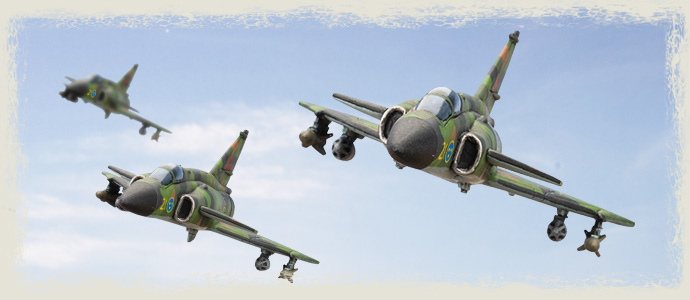
|
|
The Swedes also get their own unique aircraft in the form of the AJ 37 Viggen Attack Group (TSWBX07)
Like the Finns, the Swedes have their own infantry range to represent their unique uniform and weapons. The Armoured Rifle Platoon (TSW702) pack contains 1x AK 4 Rifle Team, 3x Ksp-58 MG Team with P-skott m/68 or Ksp-58 MG Team with P-skott m/86, 3x Grg m/48 Anti-tank Team, and 1x RBS-56 BILL Missile Team.
The Swedes are both an effective and good-looking force.
|
|
|
Norway
During the Cold War, Norway held the dubious distinction of being one of only two NATO nations to share a border with the Soviet Union.
With the likelihood of war growing, it seemed Moscow’s priorities in Norway centred on destroying or capturing Norwegian airfields to prevent them from being utilised for offensive operations against military assets based in the nearby Kola Peninsula. This was combined with a planned offensive into northern Norway to secure these facilities for their own use. Once captured the Soviets could then use these as a base for offensive air and naval operations against NATO forces in the North Sea and North Atlantic.
|
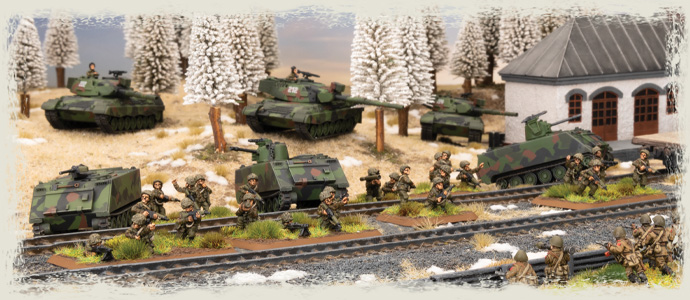 |
| The Norwegians have more conventional equipment, fielding Leopard 1 tanks in their armoured forces and M113s, with locally modified variants for their mechanised cavalry. |
|
Norwegian Formations
Brigaden i Nord-Norge (Brigade in Northern Norway, or Brig N) is the Norwegian Army’s (Hæren) main standing regular formation. In the event of war, it would be deployed immediately to the Finnmark border area on border containment. Bother the infantry and tanks units of this brigade are all members of the Norwegian Cavalry branch of the army.
In the mid-1980s Norway’s independent tank squadrons were assembled into armoured battalions following the Swedish example and were organised as mixed formations with two squadrons of tanks and two squadrons of mechanised infantry.
|
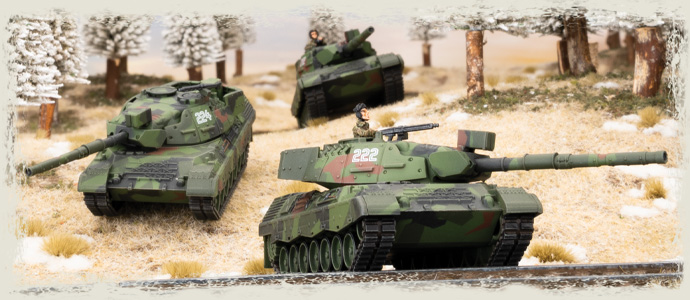 |
| Norway’s main Tank Squadrons were armed with Leopard 1 tanks. These were stationed in the north of the country where the most likely threat of Soviet attack would be directed. Though not as heavily armoured as the Soviet tanks they potentially faced, the well-trained Norwegian crews combined with the excellent 105mm L7 gun give the Leopard 1 good odds against T-55 and T-62 tanks, and with the capability of taking on T-72s with good use of concealment and movement. As well as three Tank Troops with four tanks each, a Squadron also contains an M113 Storm Troop (Infantry), an M106 107mm Mortar Troop and an NM142 Anti-tank Troop. |
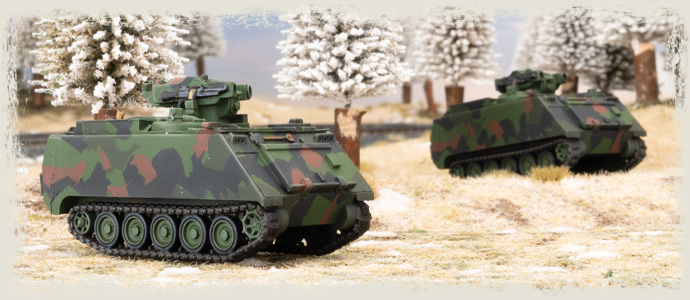 |
|
The NM142 is a Norwegian missile tank-hunter vehicle (Rakettpanserjager) based on the M113 APC. The NM142 mounts a turret containing a TOW guided anti-tank missile system, with one launch tube on each side of the turret in a concept broadly similar to the US M901 ITV.
The other two Formations in a battalion are the M113 Storm Squadrons. These have three M113 Storm Troops, a Leopard 1 Tank Troop, and either a M125 81mm Mortar Troop or M106 107mm Mortar Troop.
|
|
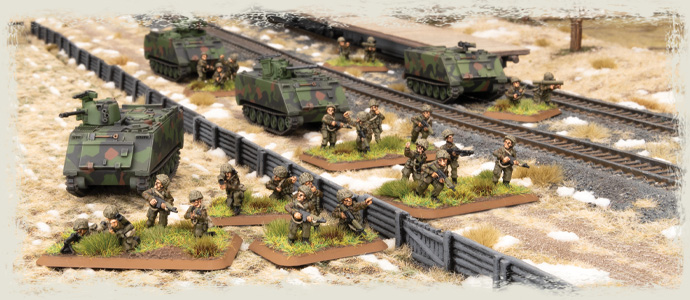
|
|
A Storm Troop is either mounted in a mix of M113 APCs and NM135 IFVs, or entirely with NM135s. The NM135 is another Norwegian upgrade to the M113, mounting a 20mm autocannon in a small turret. The Storm Troop is armed with MG3 machine guns, Carl Gustav recoilless anti-tank weapons, G3 battle rifles, and 66mm M72 LAW disposable anti-tank rockets. This equates to 4x MG3 teams with M72 LAW anti-tank and 3x Cark Gustav anti-teams. The Carl Gustav anti-tank teams can also be replaced with Eryx anti-tank missile teams.
The Eryx anti-tank missile is a French short-range guided missile system (range 16”/40cm, AT24, HEAT, Tandem Warhead) giving them a weapon with a much higher punch than the Carl Gustav, but it cannot be used in Assaults (special rule No Assault).
|
|
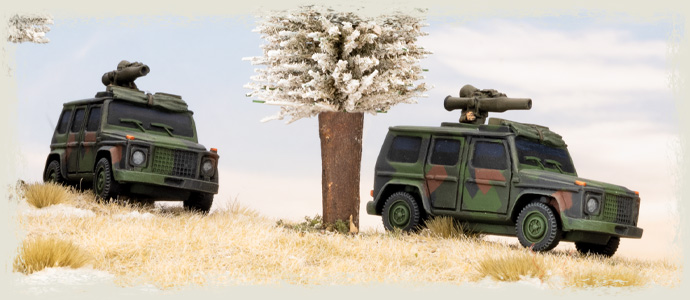
|
|
Norwegian Support includes Feltvogn (TOW) anti-tank section which mounts an iTOW on a Mercedes-Benz 240GD Geländewagen. The Mercedes-Benz 240GD Geländewagen is also used as a reconnaissance vehicle with the Feltvogn Recon Troop. Further modified M113s are used for Observation, and in the NM195 Air Defence Battery armed with the Swedish RBS-70 SAM. Like many NATO forces, the Norwegians use the M109 for their self-propelled artillery and have both the long and short howitzer versions. The NM135 is also used as a recon vehicle.
Norwegians have access to NATO Allies as Formations, as well as US Marine Units as part of their Force Diagram.
|
|
Norwegian Models
For the Norwegian Leopard 1 use the West German Plastic Leopard 1 Panzer Zug (TGBX14), building the cast turret version. The American M109 Field Artillery Battery (TUBX24) provides the plastic kit for the Norwegian M109. To get M113 APCs, M125 or M106 mortar carries use the West German M113 Panzermörser Zug (TGBX09).
|
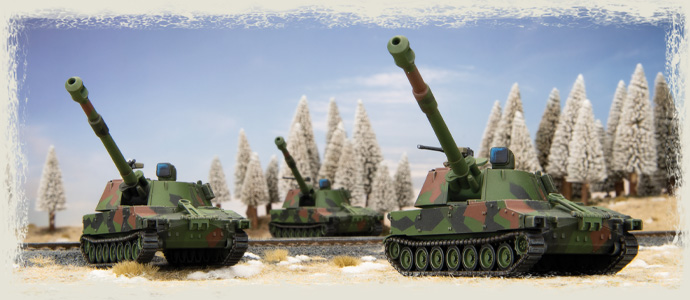 |
|
The new Norwegian Feltvogn Recon Troop (TNOBX03) provides five resin 240GD Feltvogn/Mercedes Jeeps with 4x 7.62mm AA MGs, 2x .50 cal AA MGs, and 4x TOW Missile options.
The NM142 Anti-tank Troop (TNOBX02) plastic and resin kit lets you build four NM142 tank-hunters.
In the NM135 or NM195 Platoon (TNOBX01) plastic and resin kit, you can build either four NM135 Transports or NM195 RBS-70 AA Missile Carriers.
|
|
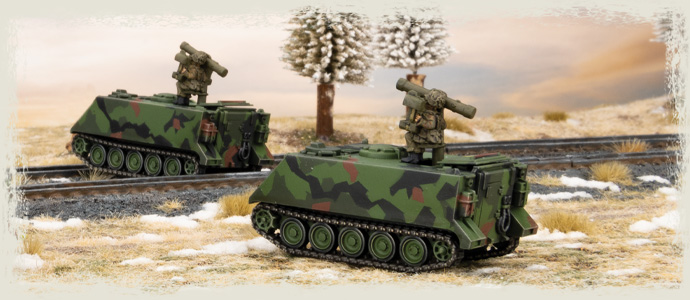
|
| For your Norwegian infantry need we have a new M113 Storm Troop (TNO702) pack which contains 1x G3 rifle team, 4x MG3 team with M72 LAW anti-tank, 3x Carl Gustav anti-tank teams and 3x Eryx anti-tank missile teams. |
|
|
Denmark
The Danish Jyske Division was responsible for the defence of the Jutland Peninsula and constituted the second half of the two main components in the LANDJUT (NATO Allied Land Forces Schleswig- Holstein and Jutland) Corps. In case of rising tensions between the West and the East, the division would start the mobilisation of its reserve forces and deploy its three brigades into their forward defensive positions, in and around Schleswig-Holstein, where they would meet up with their West German counterparts.
Each of the three brigades was made up of one tank battalion, two mechanised infantry battalions, and one artillery battalion. Furthermore, each brigade had an armoured engineering company assigned to it. A Danish tank battalion was made up of two tank squadrons and one mechanised infantry company, while each mechanised infantry battalion comprised two mechanised infantry companies and one tank squadron.
|
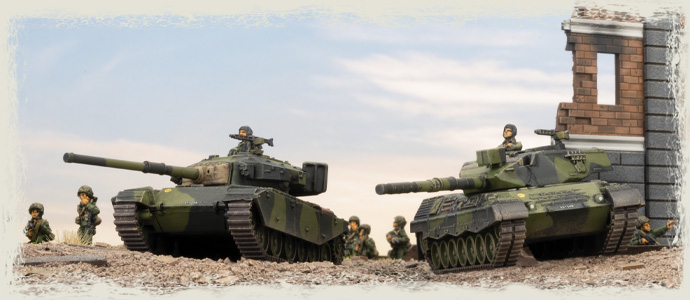 |
| The Danes have more conventional equipment, fielding Leopard 1 tanks in their armoured forces and M113s (including local variants) for their mechanised infantry. The Danes also field two variants of Centurion tanks. |
|
Danish Formations
A Danish Leopard 1 Tank Squadron is based around three Leopard 1 Tank Platoons of three tanks. In addition, the Formation contains an M113 Armoured Infantry Platoon, an M106 120mm Mortar Platoon, an M113 TOW Platoon and M109 SP Howitzer Battery.
|
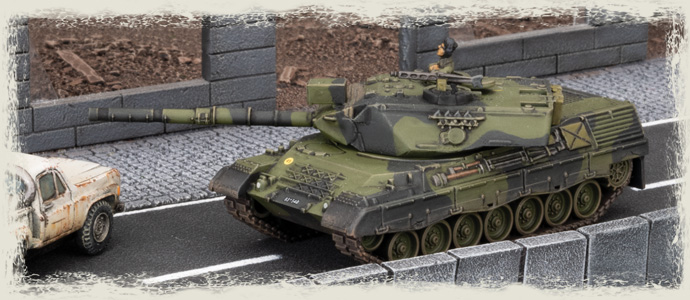 |
| The Leopard 1A3 (angled welded turret) replaced the Centurion in front-line service with the Jutland brigades between 1976 and 1978. The Leopard 1 was chosen over the Centurion for its increased speed and manoeuvrability. Another consideration was that the Leopard 1 was used by the West German Bundeswehr, with which the Jutland brigades would cooperate if war broke out, allowing them to share supplies and logistics. Like all Leopard 1s, though lightly armoured, it was armed with the excellent fully stabilised 105mm L7 gun with a Laser Rangefinder. |
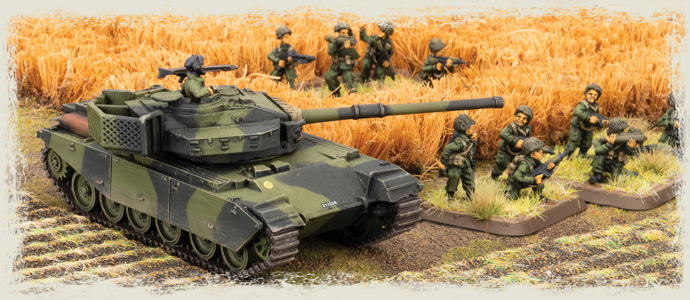 |
|
Denmark’s other tank squadrons defending Denmark’s islands were armed with the Centurion DK. The Centurion DK was armed with the British 105mm L7 gun, had increased night fighting capabilities, a laser rangefinder and a primitive thermal sighting system, known as a thermal tracer. With the new designation as Centurion Mk V, 2 DK, usually called Centurion DK for short, they served for the remainder of the Cold War with the Zealand (Sjælland) brigades.
The Panserinfanterikompagni (Armoured Infantry Company) formed the core of the Danish Army in 1964 when the first batch of M113s entered Danish service. The company was made up of a command section with one M113 transport and three platoons of infantry with M113 transports. Furthermore, the infantry company had a mortar section of two M125 mortar carriers, that in some companies were replaced by M106 mortar carriers. Finally, it also had a section of M113 TOW vehicles. The M113 Armoured Infantry Company could also have a Unit of tanks attached.
|
|
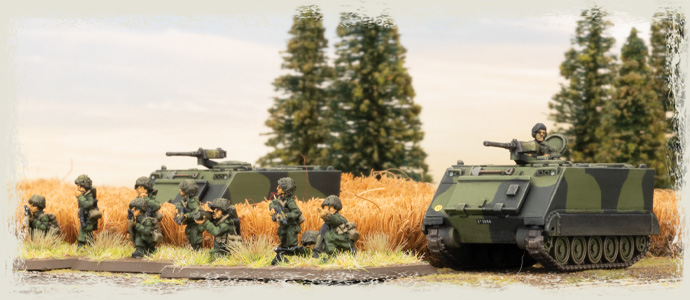
|
|
A Danish Panserinfanteri Deling (Armoured Infantry Platoon) was generally made up of three groups. Each, in turn, was made up of around nine to eleven soldiers led by a sergeant. Each group was armed with one M/62 (MG3) machine gun, one M/79 (Carl Gustav) recoilless rifle, M/72 LAWs and M/75 (G-3) semi-automatic rifles. A full-strength platoon contains 3x MG3 team with M72 LAW anti-tank, 3x Carl Gustav anti-tank team (small base teams), and 3x M113 APCs.
Long-range anti-tank capabilities came from the tanks or the M113 TOW Platoon which mounted an improved TOW on a M113 APC, much like the Canadian M150 (TOW). Mortars were carried in the standard M125 and M106 configurations, though the Danes, like the West Germans, replace the 4.2-inch/107mm mortar with a Finnish Tampella 120mm mortar in the M106.
The M109 SP Howitzer Battery can be armed with short or long-barrelled 155mm howitzers.
|
|
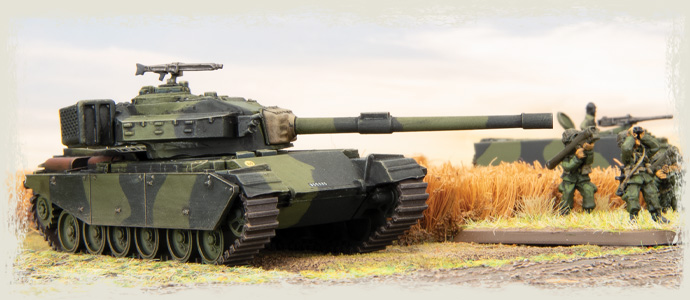
|
|
Support Units include the Centurion Tank-hunter Platoon, which uses older Centurion tanks, which were mostly Centurion Mk V tanks armed with the 20 pdr (84mm) guns. These were manned primarily by Reserve personnel, which were mobilised in the case of an imminent conflict. These would mostly have assisted infantry, in prepared defensive positions.
The Redeye Air Defence Group were assigned to specific sectors of the area of operations or could be assigned to companies to provide air defence with their Redeye MANPADs. The M113 OP provides observation for artillery units, while the Scout Group mounted in Mercedes jeeps are your force's eyes and ears.
Danes have access to NATO Allies as Formations, as well as West German Units as part of their Force Diagram.
|
|
Danish Models
Danish Leopards come from the West German Leopard 1 Panzer Zug (TGBX14) building the variant with the angular welded turret.
The Danish Centurion Tank Platoons can be built from the Swedish Centurion plastic box (TSWBX02).
|
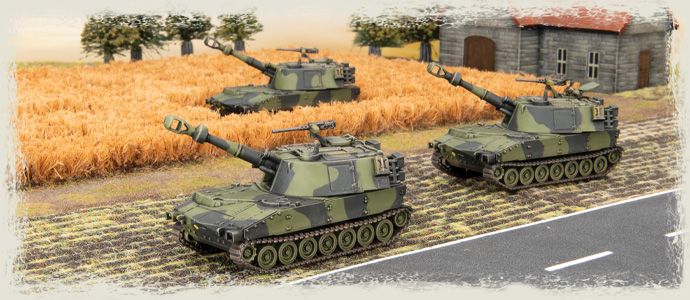 |
|
The plastic American M109 Field Artillery Battery provides the M109s you will need to build your Danish artillery.
The Danish recon Mercedes jeeps come from the Norwegian Feltvogn Troop (TNOBX03), selecting the 7.62mm AA MG option.
|
|
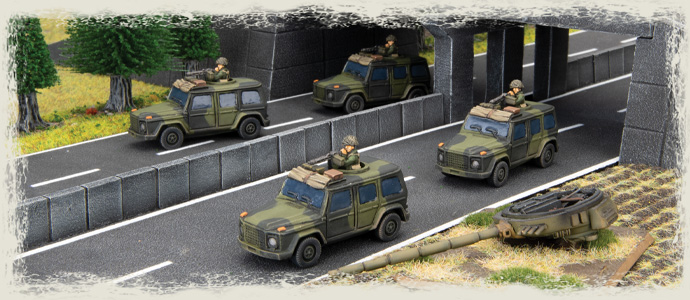
|
|
The Norwegian M113 Storm Troops also provided all the infantry you need to build an M113 Armoured Infantry Platoon.
The West German M113 Panzermörser Zug (TGBX09) provided the parts need to build the M105 120mm Mortar Platoon, while the NATO M113 Transport box gives you models to build M113 APC and M113 (TOW) vehicles.
The West German Fliegerfaust Gruppe provide the models for the Danish Redeye SAM teams.
|
|
| If you are looking for an army that is a little different, or an interesting side project, Nordic Forces contains a great variety of choices that just may pique your interest.
I hope you enjoy it!
~Wayne
|
|
|
|